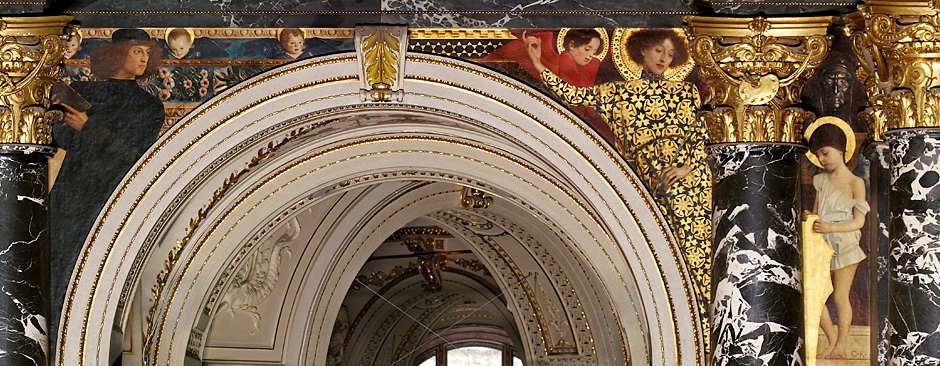The lesson I have learned again and again during the course of academic study: Research can take you anywhere. This becomes a deeper and greater truth as one moves from an undergraduate interest, fevered Masters work, to the long-sustained journey of a doctorate.
Arriving at the British Library this past week for the first time, I thought my time there would have been the adventure in itself. The gaping brick archway, the interior plaza, the clatter of locker doors and feet dashing up and down successive stairways as Academia's labourers, young and old, marched in and out of darkened reading rooms like bees in a hive. It was like a train station for any and all kind of querying researcher - the glassy, mirrored elevators even announced the 'stops' at each floor, rattling off: 'Social Sciences Reading Room, Music Room, Manuscript Library....'

And as a great heap of albums was plunked before me in the Manuscripts room, I thought for sure I would never leave! Windowless and chilled by air conditioning, the room enclosed researchers who seemed motionlessly absorbed in their own work. As I began to comb through Burne-Jones's accounts of the weather, of complete and incomplete commissions, of dinner parties joyful and tedious, I felt that I too would be bound up in my albums - much like the other researchers, much like the letters themselves!
However, the reading of the letters brings you on an imaginative, investigative journey through the realms of another person's world, other people's times - the places and things they loved, hated, or just thought about on a regular basis. It is a mystery, piecing together the hints and fragments of their lives through the scribbled notations of a quickly-moving, rapidly-thinking artist's hand. And this time, the mystery led me beyond my imagination, out of the library and to the heart of the experiences many of the letters recounted.
Later in life, Burne-Jones spent much time by the seaside, supplementing his health with the fresh salty air and designing quietly in his studio. Writing to his young friend Mrs. Haskell, he recounts the joys and struggles of his work, of missing grown children, of a nagging wife...of his both hopeful and sorrowful relationship with God and heaven. He specifically addresses these topics when recounting the characters he sees regularly at his church - obsessed with the high-booted, 'very very old' Vicar who is fond of hunting - and the windows that Burne-Jones not only designed but paid for himself, dedicating them to his daughter there. When they were put up in 1893, Burne-Jones made a point of explaining the event and describing the pieces to Haskell:
The window is up and looks bummy [can anyone tell me what that might mean in this context? haha] and glows - the grave-digger says it's the splendidest thing in Sussex.
There are 3 lights – and on the left hand is Gabriel and under him a little panel of the Annunciation and he says – but of course in Latin which is his native tongue “I am Gabriel the Archangel, the messenger of great joy."
And in the middle light is Michael – and under him a panel of his fight with the dragon – and he says I am Michael the Archangel, captain of the hosts of heaven."
And then comes Raphael (not the painter) and he has a little picture under his of a guardian Angel leading Angela [Thirkel - his granddaughter] through the streets of London and he says – “I am Raphael, keeper of the Lord’s little ones."
And I daren’t ask how much it will cost to make – it’s the only way if you want anything, not to ask how much – and there it is – it’s a thankful offering for Margaret and it said in Latin in a very narrow band.
And it glows and glows the window does.
I was exuberant! This was very exciting to find for my research, as often Burne-Jones's involvement in church and religious life is questioned - this sustained conversation about religious life and its significance for his personal and artistic goings-on go far to deepen our understanding of the role of his faith in his life and art (complex as his faith - or any one else's for that matter - is).
A 'double-check' on the letters' addresses and letter-headings revealed he was writing from Rottingdean, where he had his home at the 'North End House' across the street from the church of St. Margaret of Antioch. This required a bit more digging - an investigation not to be undertaken in the cool shadowed spaces of the British Library but out onto the roads, into the sunshine and to the (never-before-seen) English seaside!
So as they say in the movies: "ROAD TRIP!!!!!!!!!"
A two hour drive to the swelling hillsides of Sussex brought me not only to the windows, but the very town Burne-Jones talked of walking through - the seaside air he breathed - the house he lived in and wrote from - the church with the 'very' old vicar and the windows he took such pains and care and love to dedicate to his daughter. They were just as the gravedigger described, just as he himself said: 'the splendidest thing in Sussex'; all 'bummy' and glowing! That day, the letters came to life!
 |
| St. Margaret of Antioch's |
 |
| The glowing 'bummy' windows |
 |
| Burne-Jones's home right across the town square. |
 |
| And just down the street - the beach! |
 |
| Some shots of the beautiful blue-sky town. |
 |
| The memorial to Edward Burne-Jones and wife Georgiana at the church. |




















































